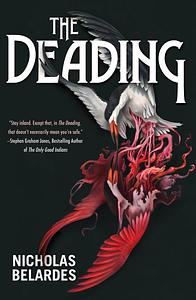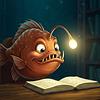Take a photo of a barcode or cover
DNF at page 42.
Beautiful cover art and a compelling synopsis can't save the prose on this one. The Deading reads more like a dry academic textbook on oyster farming and birding than a horror novel, and it didn't take long for boredom to outweigh my patience. Moving onto my next read...
Beautiful cover art and a compelling synopsis can't save the prose on this one. The Deading reads more like a dry academic textbook on oyster farming and birding than a horror novel, and it didn't take long for boredom to outweigh my patience. Moving onto my next read...
challenging
slow-paced
Plot or Character Driven:
A mix
Strong character development:
No
Loveable characters:
No
Diverse cast of characters:
Yes
dark
emotional
mysterious
reflective
sad
tense
medium-paced
Plot or Character Driven:
A mix
Strong character development:
No
Loveable characters:
No
Diverse cast of characters:
No
Flaws of characters a main focus:
No
I’m glad I won a copy of this book through a Goodreads giveaway. I pushed myself to finish because I am a completionist at heart, but it’s really hard to recommend or share, which begat my rating. I would have been even more disappointed had I paid money.
I agree with many reviewers here: the book tries to do too much and suffers for it. As a fan of horror, especially stories involving occult and undead, I was drawn to the jacket description thinking this would be genre-bending, if not redefining. Sadly, the whole premise of “deading” felt more like characters simply having a seizure through which they survived. At first blush, it seemed like the author wanted to use zombie tropes but quickly abandoned the shambling masses and horror that comes from the apprehension of being pursued by a threatening horde. There was no terror established with deading.
That left me wanting more explanation of the “magic system” of deading - how was it that it afflicted certain characters but not others? What was their common thread or characteristic? What about those that deaded? What was their connection? Not enough was said about the difference between some deaders, especially Chango. There were seeds planted with a slight nod to Lovecraft, but definitely not grown. The author could learn a lot from Stephen King’s The Stand.
Very little was said about the actual impact of deading on an individual - for example, I kept wishing for more to be said about why this drove deading characters towards the cult-like division against non-deaders. Why did they choose to start calling themselves Risers? So much more could have been explored here to amp up the terror between the two factions.
There’s also a question of world building - the birding side is overly detailed and repetitive to the detriment of the actual world state, mostly represented by the government / military presence (or lack thereof). The birding world seems anchored in the present, while the rest of the world is written far more futuristically, where drones and AI seem to have advanced to near autonomy. This really disrupts the reader’s connection to the world. Again, trying too much.
While I didn’t mind the first person / third person narrative switching or even character to character exposition changing, these switches muddy how much I resonated with the characters. While Blas appears to be the main character, the narrative switching could have supported his story much better by connecting all of the characters to him in more congruent ways. Telling this from Blas’ first person point of view would have been a much better narrative choice.
I also read this book coming off _A Light Most Hateful_ - both books are reliant on the outrageous illustration of fantasy elements that likely were solid images in the authors’ minds, but translate poorly in their superfluous prose. Sometimes simpler is better.
I agree with many reviewers here: the book tries to do too much and suffers for it. As a fan of horror, especially stories involving occult and undead, I was drawn to the jacket description thinking this would be genre-bending, if not redefining. Sadly, the whole premise of “deading” felt more like characters simply having a seizure through which they survived. At first blush, it seemed like the author wanted to use zombie tropes but quickly abandoned the shambling masses and horror that comes from the apprehension of being pursued by a threatening horde. There was no terror established with deading.
That left me wanting more explanation of the “magic system” of deading - how was it that it afflicted certain characters but not others? What was their common thread or characteristic? What about those that deaded? What was their connection? Not enough was said about the difference between some deaders, especially Chango. There were seeds planted with a slight nod to Lovecraft, but definitely not grown. The author could learn a lot from Stephen King’s The Stand.
Very little was said about the actual impact of deading on an individual - for example, I kept wishing for more to be said about why this drove deading characters towards the cult-like division against non-deaders. Why did they choose to start calling themselves Risers? So much more could have been explored here to amp up the terror between the two factions.
There’s also a question of world building - the birding side is overly detailed and repetitive to the detriment of the actual world state, mostly represented by the government / military presence (or lack thereof). The birding world seems anchored in the present, while the rest of the world is written far more futuristically, where drones and AI seem to have advanced to near autonomy. This really disrupts the reader’s connection to the world. Again, trying too much.
While I didn’t mind the first person / third person narrative switching or even character to character exposition changing, these switches muddy how much I resonated with the characters. While Blas appears to be the main character, the narrative switching could have supported his story much better by connecting all of the characters to him in more congruent ways. Telling this from Blas’ first person point of view would have been a much better narrative choice.
I also read this book coming off _A Light Most Hateful_ - both books are reliant on the outrageous illustration of fantasy elements that likely were solid images in the authors’ minds, but translate poorly in their superfluous prose. Sometimes simpler is better.
Loving the concept of snail-zombies and cult vibes, but 90% of the book so far has been about birdwatching. And the writing is really hard to follow.
slow-paced
Plot or Character Driven:
Plot
Strong character development:
No
Loveable characters:
No
Diverse cast of characters:
Yes
adventurous
dark
mysterious
tense
slow-paced
Plot or Character Driven:
A mix
Strong character development:
No
Loveable characters:
No
Diverse cast of characters:
Yes
Flaws of characters a main focus:
No
slow-paced
Plot or Character Driven:
Character
Loveable characters:
No
what even was this man so many tangents on birds and dead husbands and social media
adventurous
challenging
dark
mysterious
tense
slow-paced
Plot or Character Driven:
A mix
Strong character development:
Complicated
Loveable characters:
Complicated
Diverse cast of characters:
Yes
Flaws of characters a main focus:
Complicated






